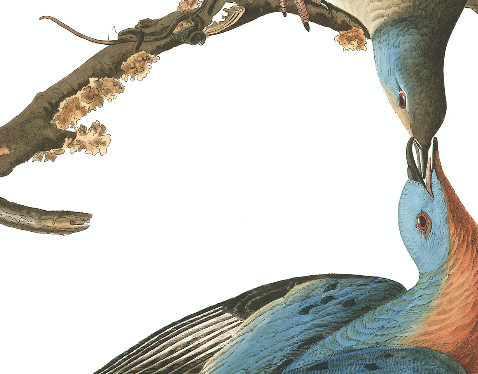
Above ––
Plate 62. Passenger Pigeon. Columba Migratoria. Linn., one male and one female. Drawn from nature and published by John J. Audubon. Engraved, printed, and coloured by Robert Havell Sr. (1827-1838).
The Birds of America
The birds were singing around me, but I reflected that the very birds were strangers to me, for I did not know their names; and that seemed to me the saddest of all.
— Margaret Atwood [1]
Landscape architecture and architectural renderings reflect our aspirations–explicitly or otherwise–about the world in which we live and about the world in which we hope to live. Too often these images are populated by eerily similar figures selected for their appearance rather than representational accuracy.
In or around 1820, the taxidermist, portrait and sign painter John James Audubon declared his intention to document and paint every bird in North America. Travelling down the Ohio and the Mississippi Rivers, he observed, documented and painted the avifauna of America. After his travels, Audubon would spend just over a decade (1827 to 1838) working painstakingly with Robert Havell Sr. and Jr. to bring the plates to publication in a richly illustrated, double-elephant folio masterpiece, The Birds of America.
Recently posted online by the John James Audubon Center and the Audubon Collection[2] the 435 birds of America are in the process of being carefully removed from their high resolution plates in the chronological order in which they were originally drawn from nature and will be posted online, available as downloadable cutouts in an open access database.
The goal of transforming The Birds of America into an open access database is twofold. First it looks to remove structural obstacles to representational accuracy and biodiversity of the avifauna of the Americas by giving landscape architects, architects, design students–any one with an internet connection–access to a database of free, high-resolution, PNG images. And, second, it hopes to broaden the legacy of the wildlife illustrations of John James Audubon by encouraging a conversation (not limited to design and design-adjacent fields) about careful observation, knowledge production, open access, and the significance of accuracy and diversity in landscape architecture and representation.
Future projects include the avifauna of other geographical regions and will be announced on this site.
Notes
1. Atwood, Margaret. Alias Grace. New York: Anchor Books, 1996. pp. 260.2. Original free high resolution plates are courtesy of the John James Audubon Center at Mill Grove and the Montgomery County Audubon Collection and may be found here.
Looking for databases of free, high-res, PNG images that reflect human diversity in all its forms? Visit NONSCANDINAVIA, skalgubbar, escalalatina, Kaleidoscope, Just Not The Same, Cut Out Life, and Juan Carlos Ramos.